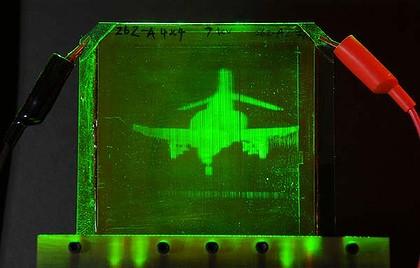Holographic Video Conferencing Technology
Read about the new kind of optical technology called Holographic Technology.Everybody must have seen Google video calling technology. Some of you may have used it. Have you ever thought of talking with a person in 3D whose is at some place in the world just like Google Video calling? Don’t worry It might be possible in the coming years then thanks to the new kind of optical technology called Holographic Technology.
Holographic Technology - Introduction

STAR WARS is one of the famous Hollywood films. In this film there is a scene in which a 3D image of a lady is produced who seeks out for help. The science fiction story at that time is now going to be real thanks to the new 3D holographic technology and its developers. Holographic technologies are not too strange now. Continuous researches in the field of holographic technologies have led to the discovery of making it real and practical. Massachusetts Institute of Technology or simply MIT created the first holographic display back in 1989. Arizona University also created a 3D hologram prototype which refreshes at every 4 minutes. Now holographic images of high quality are produced which refreshes at every 2 seconds. Science behind Holograms
Holography is the technology by which objects are shown in the space without the help of screens. Such holograms can be viewed in the environment as we see other objects. Invention of Holography led to the invention other applications using Holography. One such application is the 3D Tele-presence. 3D tele-presence is the technology by which an incident happening at some other place is displayed as 3D holograms in real time. It will be just like witnessing the incident from another place in 3D in real time. We can see such examples in the film I mentioned above (STAR WARS). Even though it is not real the fact is that we do not have computing powers to display such images instantly and there is no holographic media have been invented to update these images. The current trend in the technological field demands more from the developers of technology and producers are willing to give more to invent new technologies. We can say it is the time of 3D now. 3D films are welcomed every where in the field and the demand for it is only increasing. Such a rush to new technologies encourages the researchers to concentrate on Holographic technologies.Recent Developments in Holography
3D Holographic imaging is now developed in the College of Optical Science in Arizona University. There is no need for 3D gasses and related instruments to view Holograms developed in this college. They can project the images into space without the need of such tools. It is a new kind of holographic tele-presence. 3D tele-presence in now finding its ways in 3D Telemedicine, Advertising, Updatable 3D Mapping and related Entertainment fields.
Large 3D static images can be rebuilt by giving high resolution and depth with the help of Holographic Steriography. The main part of this system is the Photo-refractive screen. It can refresh in every 2 seconds. This prototype is the first system to be called as the Quasi Real Time fast. 10 inch large screens are used commonly. 17 inch large scrrens are also developed by scientists. Image is recorded with the help of using a series of cameras. Each camera views the object in different angle. The quality of the image depend upon the number of cameras used.
The images are encoded into a fast moving LASER. It interferes with another LASER beam which is used as the reference beam. The interference pattern obtained here is recorded with the help of Photo-refractive flatforms. It is stored as a Hologram. Each LASER pulse records each Hogel. Hogel is the short name for Holographic pixel. Hogel is the 3D version of thebasic unit of an image- pixel. New 3d images can be recorded in the hologram by erasing the old one. Application of Holographic Technology
The requirements of using holographic technology in any office or industry will be like placing a number of cameras around the conference hall and a very high speed internet connection. This is a little unpractical at the moment. But every system will be automatic if you have such technology along with a 3D display at the other end. Image signals are transmitted and rentered fully automated.
It will not respond to vibrations in the surroundings as it uses short pulse duration of LASER. So it can be used in places where noise and temperature cannot be controlled fully. An example for such a site is an industry. Full parallax can be obtained in this technology which is not obtained so far in any other technology. So if the object is moving during the time of recording it can be identified. We will feel that the object has life.
This technology is developed in association with an industry NDT. They provide the polymer for recording purposes. Tele-medicine will find this technology much useful. Doctors can view and engage in surgery in 3D from different places. This type of holograms does not require high computing powers.Future hopes in the field
The Tele-presence system available today can only have images in one colour. But the Tele-presence system in future will have real colours and good refresh rates.

 Job oriented
Job oriented